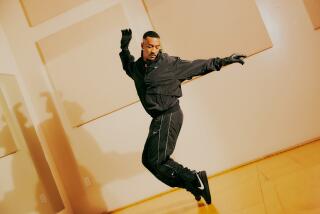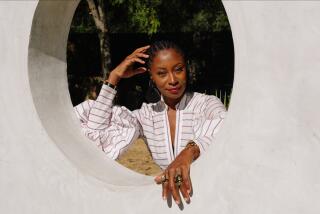Tere O’Connor Dance group
Spectators sat on 56 chairs positioned at various angles around the Getty Gallery at the Skirball Cultural Center. Four dancers began slowly walking through and around them, then picked up the pace until they were running and brushing almost dangerously close to the rapt if bemused audience.
The award-winning, New York-based Tere O’Connor Dance group, formed in 1985, had arrived Thursday to make its Los Angeles debut in the choreographer’s four-part “Rammed Earth.”
FOR THE RECORD:
Tere O’Connor Dance: A review in Saturday’s Calendar section of a Tere O’Connor Dance concert at Skirball Cultural Center identified the couple who closed the performance as Christopher Williams and Matthew Rogers. They were Williams and Heather Olson. —
Describing O’Connor’s choreography is risky business. In a 2005 letter to the New Yorker, O’Connor excoriated critic Joan Acocella -- and critics in general -- for not knowing “how to read dances.”
“They can’t do the work of finding out what is actually going on in the minds of the artist or what are the contexts in which these works are created,” he wrote. “They have reduced dance criticism to an explanatory, superficial, retelling of events.”
O’Connor was unhappy with Acocella for lumping him with three other downtown choreographers under the rubric of surrealism. And because the letter wasn’t published, he distributed it widely through Dance Insider On-Line magazine, causing a predictable brouhaha.
Little of that anger was evident during a post-performance Q&A Thursday, however, when O’Connor patiently, genially and with some eloquence explained his conception of dance as, in part, an exploratory process that involves the audience and continues in their minds after the performance is finished.
In a 2002 Dance Magazine article, he called his style “expressionist,” but one is tempted to use another elusively abstract term, “phenomenological,” in the sense of an exploration of consciousness.
By rearranging the audience’s seating for each part of “Rammed Earth” (a floor plan was given out before the performance), O’Connor made people aware of the relativity of their viewpoints. Because the choreography consists of small pieces that start and stop, change direction and alter in nature (from everyday gestures to gymnastic and ballet-like moves), viewers also had to take note of their responses.
When did they get stuck interpreting or trying to impose a narrative? When did they lose interest or space out? When did they grasp a moment of emergence of what O’Connor called a developing architectural form? (The dance’s title is a reference to building a house by compacting dirt.)
The choreographer said in the Q&A that he did not want viewers to understand any of the dance intellectually but rather on a deeper, subliminal level. There may be few such ideal spectators, though.
Instead, those at Skirball seemed likely to remember only moments: dancers arranging one another’s limbs into mannequin-like poses, for instance, or Matthew Rogers repeatedly slamming Christopher Williams into a wall, until the worm turned.
Also: Rogers turning a kind of cordial stance vis-à-vis the other dancers -- with Heather Olson as the central figure -- into an edgy, dangerous game that was ultimately resolved peacefully only when the group reverted to its original configuration. Or Hilary Clark precariously balanced and scanning the audience’s faces warily. Or Williams and Rogers closing the work in a quiet embrace at the far end of the rectangular gallery, as if seen from the wrong end of a telescope.
Even with James Baker’s moody electronic score and Michael O’Connor’s evocative lighting design, much of the work remained abstract and uninvolving.
Everyone will have a different take on it, of course, which seems to be OK with O’Connor. Or maybe not. Perhaps a letter to the editor will follow.
More to Read
The biggest entertainment stories
Get our big stories about Hollywood, film, television, music, arts, culture and more right in your inbox as soon as they publish.
You may occasionally receive promotional content from the Los Angeles Times.






